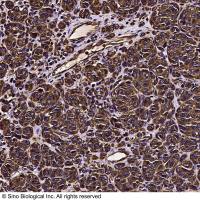Phos-tag Affinity Electrophoresis for Protein Kinase Profiling
互联网
892
Protein kinase profiling can provide a basis for understanding the molecular origins of diseases and, potentially, for developing
tools for therapeutic intervention. It is therefore very important to develop advanced experimental procedures for convenient
and accurate determination of the phosphorylation status of certain substrate proteins in the life sciences. Here, we introduce
a method for protein kinase profiling by using a novel type of phosphate-affinity sodium dodecyl sulfate-polyacrylamide gel
electrophoresis (SDS-PAGE). The phosphate-affinity site is a polyacrylamide-bound dinuclear metal complex of a phosphate-binding
tag molecule known as Phos-tag. The Phos-tag SDS-PAGE method permits detection of changes in the mobility of phosphorylated
proteins in comparison with their nonphosphorylated counterparts and thereby allows quantitative analysis of protein kinase
reactions without any special apparatus, radioactive isotopes, or chemical labels. If a kinase reaction occurs at one residue
of a substrate protein, the monophosphorylated and nonphosphorylated forms can be simultaneously detected as two migration
bands on a Phos-tag SDS-PAGE gel. In the case of hyperphosphorylation, the phosphorylated products appear as multiple migration
bands, depending on the phosphorylation status in terms of the numbers and the positions of attached phosphate groups. This
article discusses applications of label-free kinase activity profiling by the Phos-tag SDS-PAGE method in the analysis of
phosphorylated substrates derived from various kinase reactions. The resolving power of the affinity electrophoresis provides
detailed information that leads to an overview of the kinase-dependent dynamics of various substrate proteins.









